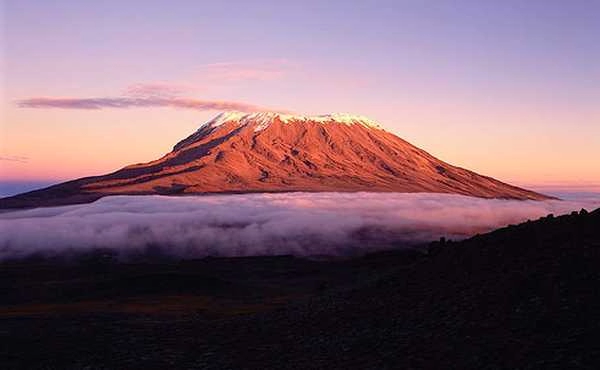The great mountain of Kilimanjaro is a metaphor for the compelling beauty of East Africa. Rising in absolute isolation, at 5,895 m (19,336 ft), Kilimanjaro is one of the highest walkable summits on the planet, a beacon for visitors from around the world.
Kilimanjaro is often called 'The Roof of Africa' as it is Africa's highest point and the world's highest free-standing mountain.

Just three degrees south of the equator, Kilimanjaro’s great peaks of Kibo and Mawenzi are covered all year round with snow and ice. Most reasonably fit and properly guided climbers can experience the triumph of reaching the crater rim with little more than a walking stick, warm clothing and determination. What makes the climb such a heavy challenge, is more from the rigours of altitude than the actual difficulty of the hike itself. The climb, which takes on average five days (you’re more likely to reach the top if you pace yourself), takes hikers through thick forests and alpine grasslands, desolate rockface and brilliant white glaciers.
There are different routes up the mountain based on your level of fitness and experience and also vary in number of days. All of the routes except the Marangu route (accommodation is in huts) require you to camp.
Marangu Route: It is referred to as the tourist route because of services available on the way to the summit. Unlike other routes, it is relatively easy, has low success rate because many unfit people attempt Kili trek via this route and fail, it is a popular route and accommodation is in huts. Many trekkers prefer it. It is also beautiful. It is the easiest and shortest route. Ascent and descent are done on the same path.
Rongai Route. Less crowded, has a higher success rate, the leeward side receiving little precipitation, it is one of the easiest routes. Accommodation is in camps.
Lemosho Route: Pristine, very beautiful, remote, has panoramic views on various sides of the mountain, it is one of the difficult routes, has highest summit success rate, and little used. Accommodation is in camps.
Machame Route: Very scenic, very popular, Good acclimatization due to walking high in the day and sleeping lower at night, the success rate is fairly high, it is a difficult route better suited for more adventurous folks. Accommodation is in camps.
Umbwe Route: It is the most spectacular and direct way to reach Uhuru Peak. It is the steepest and the toughest route, due to its steepness and as a result, used by very few people, the success rate is very low, quietest route and a jungle like a forest at the beginning of the trail is unique on Kilimanjaro offering a real sense of adventure.
Shira Route: Has good scenery, traffic not so high, It has the highest starting point require additional acclimatization, nearly identical to the Lemosho route, it has good rainforest section with wildlife spotting opportunities. Accommodation is in tents
Rongai Route. Less crowded, has a higher success rate, the leeward side receiving little precipitation, it is one of the easiest routes. Accommodation is in camps.
Lemosho Route: Pristine, very beautiful, remote, has panoramic views on various sides of the mountain, it is one of the difficult routes, has highest summit success rate, and little used. Accommodation is in camps.
Machame Route: Very scenic, very popular, Good acclimatization due to walking high in the day and sleeping lower at night, the success rate is fairly high, it is a difficult route better suited for more adventurous folks. Accommodation is in camps.
Umbwe Route: It is the most spectacular and direct way to reach Uhuru Peak. It is the steepest and the toughest route, due to its steepness and as a result, used by very few people, the success rate is very low, quietest route and a jungle like a forest at the beginning of the trail is unique on Kilimanjaro offering a real sense of adventure.
Shira Route: Has good scenery, traffic not so high, It has the highest starting point require additional acclimatization, nearly identical to the Lemosho route, it has good rainforest section with wildlife spotting opportunities. Accommodation is in tents
Those who reach Uhuru Point, the actual summit, or Gillman’s point on the lip of the crater (Kilimanjaro is a dormant, but not extinct, volcano), will have earned their climbing certificates and their memories.
There is, however, so much more to Kilimanjaro than the summit. A journey up the slopes takes visitors on a climatic world tour, from the tropics to the arctic. The grassy and cultivated lower slopes turn into lush rainforest, inhabited by elusive elephant, leopard, buffalo and antelope. Higher still, heath and moorland, covered with giant heather, becomes a surreal alpine desert and, finally, there is ice, snow and the biggest view on the continent.
It is not cheap to climb Kilimanjaro and it is best to book it in advance and not take your chances on arrival. You need to chose your dates and how many nights you would prefer (we would recommend rather taking a minimum of 6 so you can acclimatize). On the climb, you don't need to do anything except carry your day pack and your chosen trekking company will do the rest. It is vital to chose a good company so you don't have issues with any of this hence where we come in to assist you with this.
December to February are the warmest and clearest months to visit, with July to September being colder but also dry. It is wet in the rain forest from April to June and during November.

December to February are the warmest and clearest months to visit, with July to September being colder but also dry. It is wet in the rain forest from April to June and during November.

Book your This email address is being protected from spambots. You need JavaScript enabled to view it. with us so we can add on safari and/or beach in Tanzania for you.
